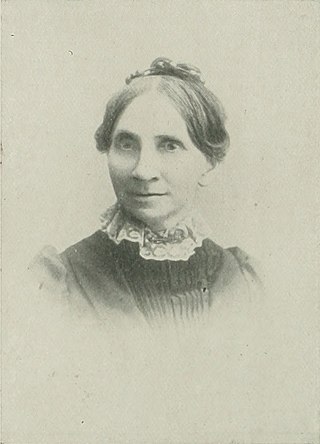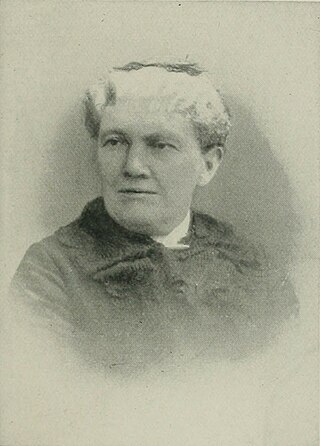
The Woman's Crusade was a temperance campaign in the United States in 1873-1874. It was a series of non-violent protests fighting against the dangers of alcohol. [1]

The Woman's Crusade was a temperance campaign in the United States in 1873-1874. It was a series of non-violent protests fighting against the dangers of alcohol. [1]
Many women in Cleveland, Ohio were inspired by a speech given by Diocletian Lewis to fight against the vices of alcohol. [2] Contemporary literature depicted alcohol abuse among men as a driver of domestic abusive, profligacy, and neglect of their duties to their families. [3] The goal of the crusade was to close as many saloons as possible using methods of prayer, song, and exhortation as customers walked in and out of the saloons.The women faced pushback by business owners who turned the tables on them by singing outside of the crusaders' homes and paying other women to mock them. [4] Ohio was the central location of the crusade, with over one-third of the events taking place there, but the crusade spread to over 900 different communities in over 31 states in the United States. [2]
The main temperance reformer of the movement was Eliza Daniel Stewart, referred to as "Mother Stewart". [5] She was a key figure in the crusade. Another figure of the crusade was Eliza Jane Thompson, who pushed the crusade by going to saloons and praying and asking the owners to pledge to stop selling alcohol. [5] They asked saloonkeepers to get rid of all their alcohol and to enter a new business. [6]
The Women's Crusade gave women the opportunity to get involved in the public sphere. In the crusade, women used religious methods because they had the most experience in that area. The movement left a lasting impact on woman's involvement in social history and led to the creation of the Woman's Christian Temperance Union. [2] Although many people were hesitant about allowing women to be involved in the Temperance Movement, women had many breakthroughs throughout the movement which led to the closure of many saloons across the United States. [7] The movement gave women the opportunity to advocate for their rights while they fought for temperance with their growing voice in the public sphere. [1]
In Xenia, Ohio, there were over a hundred saloons. [8] People gathered around these saloons and started throwing all types of alcohol into the street saluting to God to give up alcohol. A major event of the crusade was when Steve Phillips, owner of the Shades of Death (a saloon), surrendered his saloon to the movement. The closure of the Shades of Death was considered the major component of the crusade in Ohio and helped shape the Temperance movement by leading to the closure of many more saloons. [9]
Women marched throughout the street in the cold winter checking to make sure that no sales were made in the saloons. They had routines of prayers and business meetings throughout their long days on the move. The women formed distinct lines, marching on the streets to perform hymns outside of the saloons. Many of the marchers also prepared pledges for the saloonkeepers. [10]
Women organized into a women's league and they wrote their own constitution concerning their views on alcohol. One prominent stop in their march was the saloon of Thomas Chope. They were able to get into his saloon and conducted a prayer in the middle of his saloon. These prayers became known as "pray-ins". One challenge that the women faced was the refusal of some saloonkeepers to open their saloons to them. In one case, saloonkeeper Martin Cummins locked his saloon's doors, so the women were unable to enter. In cases like this, the women prayed outside the saloons to send their message about alcohol. [11]
A few of the people in Ohio and other states who were part of the Crusade: [12]

The temperance movement is a social movement promoting temperance or complete abstinence from consumption of alcoholic beverages. Participants in the movement typically criticize alcohol intoxication or promote teetotalism, and its leaders emphasize alcohol's negative effects on people's health, personalities and family lives. Typically the movement promotes alcohol education and it also demands the passage of new laws against the sale of alcohol, either regulations on the availability of alcohol, or the complete prohibition of it.
The Woman's Christian Temperance Union (WCTU) is an international temperance organization. It was among the first organizations of women devoted to social reform with a program that "linked the religious and the secular through concerted and far-reaching reform strategies based on applied Christianity." It plays an influential role in the temperance movement. Originating among women in the United States Prohibition movement, the organization supported the 18th Amendment and was also influential in social reform issues that came to prominence in the progressive era.

Caroline Amelia Nation, often referred to by Carrie, Carry Nation, Carrie A. Nation, or Hatchet Granny, was an American who was a radical member of the temperance movement, which opposed alcohol before the advent of Prohibition. Nation is noted for attacking alcohol-serving establishments with a hatchet. She married David Nation in 1874. She was previously known by either her birth name, Carrie Moore and, after her first marriage in 1867, as Carrie Gloyd.

The Anti-Saloon League, now known the American Council on Addiction and Alcohol Problems, is an organization of the temperance movement in the United States.

Martha McClellan Brown was an American lecturer, educator, reformer, newspaper editor, and major leader in the temperance movement in Ohio.

Eliza Daniel Stewart was an American early temperance movement leader. She sometimes referred to herself as "Mother Stewart".

Eliza Jane Trimble Thompson (1816–1905) was a temperance advocate.

Mary Greenleaf Leavitt was an educator and successful orator who became the first round-the-world missionary for the Woman's Christian Temperance Union (WCTU). Setting out on virtually non-stop worldwide tours over a decade, she "went to all continents save Antarctica," where she crusaded against alcohol and its evils including domestic violence; and advocated for women's suffrage and other equal rights such as higher education for women. In 1891 she became the honorary life president of the World's WCTU.

In the United States, the temperance movement, which sought to curb the consumption of alcohol, had a large influence on American politics and American society in the nineteenth and twentieth centuries, culminating in the prohibition of alcohol, through the Eighteenth Amendment to the United States Constitution, from 1920 to 1933. Today, there are organizations that continue to promote the cause of temperance.

The Woman's Christian Temperance Union Administration Building is a historic building in Evanston, Illinois, United States. It has served as the publishing house and national headquarters of the Woman's Christian Temperance Union since its construction in 1910. The organization had an important role in the national discussion on prohibition and women's suffrage.

Harriet Calista Clark McCabe was an American pioneer in women's work for temperance and home missions. She took a responsible position in the formation of the Woman's Christian Temperance Union (WCTU) in the period immediately following the Women's Crusade. She was the first president of the Ohio WCTU; she gave the organization its name, and drafted its Constitution. McCabe favored equal suffrage.
The temperance movement in India aims at curbing the use of alcohol in that country. In some places, the temperance movement has led to alcohol prohibition in India, with many temperance organisations continuing their work today.
The Temperance movement began over 40 years before the Eighteenth Amendment to the United States Constitution was introduced. Across the country different groups began lobbying for temperance by arguing that alcohol was morally corrupting and hurting families economically, when men would drink their family's money away. This temperance movement paved the way for some women to join the Prohibition movement, which they often felt was necessary due to their personal experiences dealing with drunk husbands and fathers, and because it was one of the few ways for women to enter politics in the era. One of the most notable groups that pushed for Prohibition was the Woman's Christian Temperance Union. On the other end of the spectrum was the Women's Organization for National Prohibition Reform, who were instrumental in getting the 18th Amendment repealed. The latter organization argued that Prohibition was a breach of the rights of American citizens and frankly ineffective due to the prevalence of bootlegging.
The First Woman's National Temperance Convention was a founding event in the establishment of the American Woman's Christian Temperance Union (WCTU).

Abby Fisher Leavitt was an American social reformer and one of the prominent figures of the Ohio Women's Crusade. Leavitt also served as Secretary of the Baptist Women's Foreign Missionary Society of Ohio and Treasurer of the Women's Crusade Temperance Union. She was the leader of the "Praying Band", who, in the spring of 1874, daily marched down to the esplanade of Cincinnati, visiting saloons, and holding meetings inside or outside of liquor saloons, and on one occasion, was arrested and temporarily imprisoned for her temerity. She was a co-publisher of the newspaper of the National Woman's Christian Temperance Union (WCTU). In 1891, as the "Round the World Missionary of the WCTU", the World's WCTU elected Leavitt its life president.

Women's Christian Temperance Union of New Zealand is a non-partisan, non-denominational, and non-profit organisation that is the oldest continuously active national organisation of women in New Zealand. The national organisation began in 1885 during the visit to New Zealand by Mary Clement Leavitt, the first world missionary for the Woman's Christian Temperance Union. The WCTU NZ was an early branch of the World Woman's Christian Temperance Union and a founding affiliate of the National Council of Women of New Zealand. Men may join the WCTU NZ as honorary members.

Matilda Gilruth Carpenter (1831–1923) was a prominent member of the Woman's Christian Temperance Union, known for leading the crusade against alcohol sales in Ohio in 1874.
Non-Partisan National Women's Christian Temperance Union was an American temperance association organized at Cleveland, Ohio, January 22, 1890, as a protest against the attitude of the Woman's Christian Temperance Union (W.C.T.U.) toward political parties.
The Second Annual Meeting of the National Woman's Christian Temperance Union (N.W.C.T.U.) was held in St. Paul's Methodist Episcopal church, Cincinnati, Ohio, November 17-19, 1875.

Mary Bynon Reese was a leader in the U.S. temperance movement, serving as lecturer, organizer and evangelist for the Woman's Christian Temperance Union (W.C.T.U.) in Ohio, Washington state, and at the national level. She was also the poet laureate of Steubenville, Ohio.
{{cite web}}: CS1 maint: multiple names: authors list (link){{cite web}}: CS1 maint: multiple names: authors list (link){{cite web}}: CS1 maint: multiple names: authors list (link)